Karelia
Coordinates: 63°N 32°E / 63°N 32°E

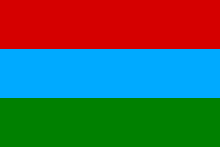
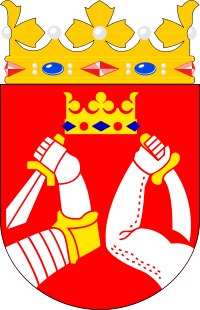

Karelia (Karelian, Finnish and Estonian: Karjala; Russian: Карелия, Kareliya; Swedish: Karelen), the land of the Karelian peoples, is an area in Northern Europe of historical significance for Finland, Russia, and Sweden. It is currently divided between the Russian Republic of Karelia, the Russian Leningrad Oblast, and Finland (the regions of South Karelia and North Karelia).
Use of name
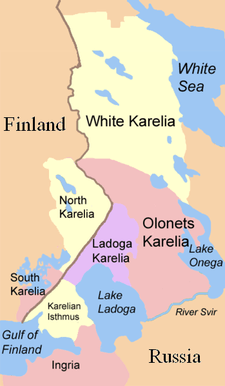

Various subdivisions may be called Karelia. Finnish Karelia was a historical province of Finland, and is now divided between Finland and Russia, often called just Karjala in Finnish. The eastern part of this chiefly Lutheran area was ceded to Russia after the Winter War of 1939–40. This area is the "Karelia" of the Karelian question in Finnish politics.
The Republic of Karelia is a Russian federal subject, including the so-called "East Karelia" with a chiefly Russian Orthodox population.
Within present-day Finland, Karjala refers to the regions of South and North Karelia, although parts of historical Karelia also lies within the region of Kymenlaakso (Miehikkälä and Virolahti, Northern Savonia (Kaavi, Rautavaara and Säyneinen) and Southern Savonia (Mäntyharju).
Geography
Karelia stretches from the White Sea coast to the Gulf of Finland. It contains the two largest lakes in Europe, Lake Ladoga and Lake Onega. The Karelian Isthmus is located between the Gulf of Finland and Lake Ladoga.
The border between Karelia and Ingria, the land of the closely related Ingrian people, had originally been the Neva river itself but later on it was moved northward into Karelian isthmus to follow the Sestra River (Russian: Сестра), today in the Saint Petersburg metropolitan area, but in 1812–1940 the Russo-Finnish border.
On the other side of Lake Ladoga, River Svir is usually thought of as the traditional southern border of Karelian territory, as Lake Saimaa marks the Western border while Lake Onega and the White Sea mark the Eastern border. In the North there were the nomadic Samis, but no natural border except for huge woods (taiga) and tundra.
In historical texts Karelia is sometimes divided into East Karelia and West Karelia, which are also called Russian Karelia and Finnish Karelia respectively. The area to the north of Lake Ladoga which belonged to Finland before World War II is called Ladoga Karelia, and the parishes on the old pre-war border are sometimes called Border Karelia. White Sea Karelia (sometimes the Finnish or Karelian term "Viena Karelia", or in some English-language sources, "White Karelia", is used) is the northern part of East Karelia and Olonets Karelia is the southern part.
Tver Karelia denotes the villages in the Tver Oblast that are inhabited by Tver Karelians.
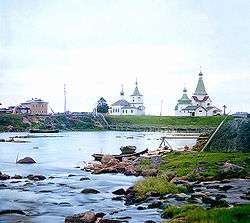
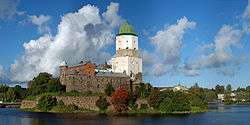
Inhabited localities
- Republic of Karelia
- Petrozavodsk (Петрозаводск, Petroskoi, from late 1941 to 1944 known as Äänislinna/Onegaborg for Finns)
- Belomorsk (Беломорск, Sorokka)
- Medvezhyegorsk (Медвежьегорск, Karhumäki)
- Kalevala (Калевала, Uhtua)
- Kem (Кемь, Vienan Kemi, compare with Kemi)
- Kostomuksha (Костомукша, Kostamus)
- Kondopoga (Кондопога, Kontupohja)
- Sortavala (Сортавала, Sortavala, Sordavala)
- Segezha (Сегежа, Sekehe)
- Pitkyaranta (Питкяранта, Pitkäranta)
- Olonets (Олонец, Aunus)
- Karelian Isthmus
- South Karelia
- Imatra
- Joutseno
- Lappeenranta (Villmanstrand)
- North Karelia
History
Karelia was bitterly fought over by the Swedes and the Novgorod Republic for a period starting in the 13th-century Swedish-Novgorodian Wars. The Treaty of Nöteborg (Finnish: Pähkinäsaaren rauha) in 1323 divided Karelia between the two. Viborg (Finnish: Viipuri) became the capital of the new Swedish province. In the Treaty of Stolbovo in 1617 large parts of Russian Karelia were ceded to Sweden. Conflicts between the new Swedish rulers and the indigenous population of these areas led to an exodus: thousands of Karelians, including the ancestors of the Tver Karelians, emigrated to Russia.

The Treaty of Nystad (Finnish: Uudenkaupungin rauha) in 1721 between Imperial Russia and Sweden ceded most of Karelia to Russia. After Finland had been occupied by Russia in the Finnish War, parts of the ceded provinces (Old Finland) were incorporated into the Grand Duchy of Finland. In 1917, Finland became independent and the border was confirmed by the Treaty of Tartu in 1920.
Finnish partisans were involved in attempts to overthrow the Bolshevists in Russian Karelia (East Karelia) in 1918–20, such as in the failed Aunus expedition. They also wanted to incorporate the rest of Karelia into Finland, and cooperated with the short-lived Republic of Uhtua. These mainly private expeditions ended after the peace treaty of Tartu. After the end of the Russian Civil War and the establishment of the Soviet Union in 1922, the Russian part of Karelia became the Karelian Autonomous republic of the Soviet Union (ASSR) in 1923.
In 1939, the Soviet Union attacked Finland, thus starting the Winter War. The Moscow Peace Treaty of 1940 handed most of Finnish Karelia to the Soviet Union. About 400,000 people, virtually the whole population, had to be relocated within Finland. In 1941, Karelia was liberated for three years during the Continuation War of 1941 to 1944 when East Karelia was occupied by the Finns. The Winter War and the resulting Soviet expansion caused considerable bitterness in Finland, which lost its second biggest city, Viipuri, its industrial heartland along the river Vuoksi, the Saimaa canal that connected central Finland to the Gulf of Finland, access to the fishing waters of Lake Ladoga (Finnish: Laatokka), and made an eighth of her citizens refugees without chance of return. (From the areas ceded to the Soviet Union, the whole population was evacuated and resettled in other parts of Finland. The present inhabitants of the former Finnish Karelian parts of Russia, such as the city of Vyborg/Viipuri and the Karelian Isthmus, are post-war immigrants and their descendants.)
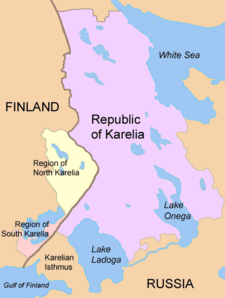
As a consequence of the peace treaty, the Karelian ASSR was incorporated with the Karelo-Finnish SSR 1941–1956, after which it became an ASSR again. Karelia was the only Soviet republic that was "demoted" from an SSR to an ASSR within the Russian SFSR. Unlike administrative republics, Soviet republics (in theory) had the constitutional right to secede. The possible fear of secession, as well as the Russian ethnic minority in Karelia may have resulted in its "demotion." In 1991 the Republic of Karelia was created out of the ASSR.
According to a Finnish nationalist source, the collapse of the Soviet Union brought an economic collapse. Since the dissolution of the Soviet Union, the area has experienced massive urban decay. The constructed buildings from the Soviet era, as well as older houses remaining from the Finnish era, are being abandoned.[1]
Politics
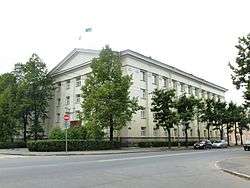
Karelia is divided between Finland and Russia. The Republic of Karelia is a federal subject of Russia, which was formed in 1991 from the Karelian ASSR. The Karelian Isthmus belongs to the Leningrad Oblast. The Finnish side consists of parts of the regions (maakunta) of South Karelia, North Karelia and Kymenlaakso.
There are some small but enthusiastic groups of Finns campaigning for closer ties between Finland and Karelia. The political expression of these irredentist hopes is called the Karelian question and is about Finland's re-acquisition of the ceded Finnish Karelia. These hopes live on, for instance, in the Karjalan Liitto and ProKarelia. However, ambitions for closer ties with East Karelia do not include territorial demands.
Demographics
The Karelian language is spoken in the Republic of Karelia and also in the Tver Karelian villages. The Veps language is spoken on both sides of the River Svir. The so-called Karelian dialects of Finnish language which are spoken mainly in Finnish South Karelia form the southeastern dialect group of Finnish. Similar dialects are also spoken in Ingria, which is an area between the Estonian border and Lake Ladoga. They appeared there in the 17th century after the Swedish conquest of the area. The older inhabitants of the Ingria, the Ingrians, have their own language which is related to the Karelian language and the south-eastern dialects of Finnish.[2] The dialects in Finnish North Karelia belong to the large group of Savonian dialects in Eastern and Central Finland. Karelians who evacuated from Finnish Karelia resettled all over Finland and today there are approximately one million people in Finland having their roots in the area ceded to the Soviet Union after World War II. In Finland, about 5,000 people speak Karelian.
Culture
See also
- Karelia Suite, a collection of pieces by the composer Jean Sibelius.
- Asbestos-Ceramic, a type of pottery made in Karelia and vicinity.
- Karelianism, a cultural movement in the Grand Duchy of Finland.
- Mastodon (band), who pay homage to Karelia on their album Crack the Skye with the song Ghost of Karelia.
- Viipurin Lauluveikot, a Finnish men's choir founded 1897 in Vyborg, Finnish Karelia.
- "The Karelian Isthmus" is the debut album of Finnish metal band Amorphis, released in 1993.
- Lauri Törni, born in Viipuri, Törni was a soldier and winner of the Mannerheim Cross during the Continuation War, who later served with the German and American armies.
References
Sources
- "They Took My Father," by Mayme Sevander and Laurie Hertzel, a history of Finnish Americans who emigrated to Soviet Karelia during the Great Depression.
External links
| Wikimedia Commons has media related to Karelia. |
- Karelians (The Peoples of the Red Book)
- Tracing Finland's eastern border - ThisisFINLAND
- Saimaa Canal links two Karelia -ThisisFINLAND
- Regional flag
- Visitkarelia.fi - Information about travel, tourism and other fields in North Karelia
- Information about Southern Karelia travel
- Pielis.ru - travel information about North Karelia region and City of Joensuu
- Karelia will return in your dreams Article about Karelia with photos and useful tourist information.
- Genocide in Soviet Karelia: Stalin's Terror and the Finns of Soviet Karelia